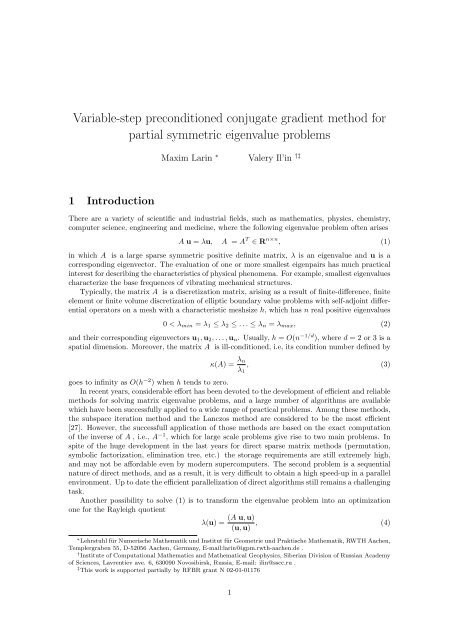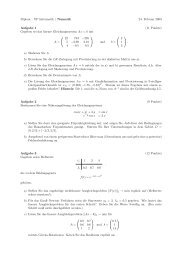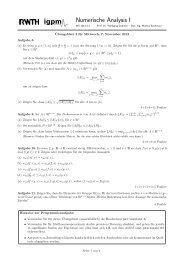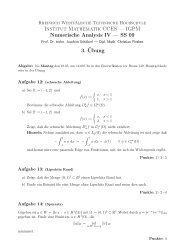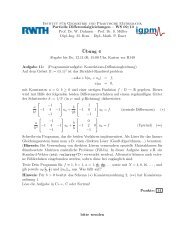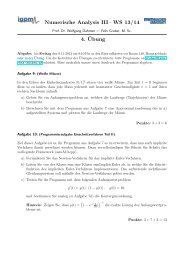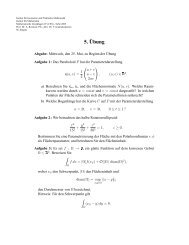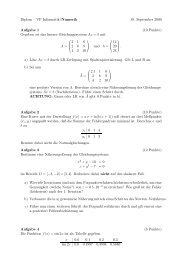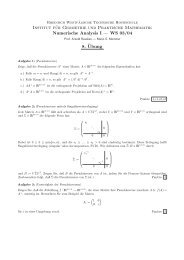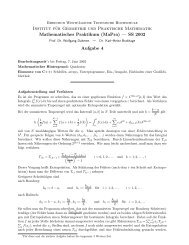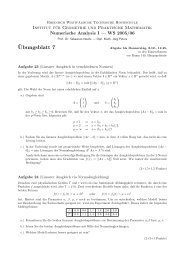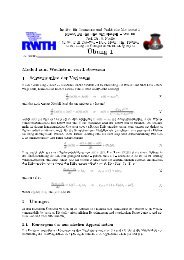Variable-step preconditioned conjugate gradient method for partial ...
Variable-step preconditioned conjugate gradient method for partial ...
Variable-step preconditioned conjugate gradient method for partial ...
You also want an ePaper? Increase the reach of your titles
YUMPU automatically turns print PDFs into web optimized ePapers that Google loves.
<strong>Variable</strong>-<strong>step</strong> <strong>preconditioned</strong> <strong>conjugate</strong> <strong>gradient</strong> <strong>method</strong> <strong>for</strong><br />
<strong>partial</strong> symmetric eigenvalue problems<br />
1 Introduction<br />
Maxim Larin ∗ Valery Il’in †‡<br />
There are a variety of scientific and industrial fields, such as mathematics, physics, chemistry,<br />
computer science, engineering and medicine, where the following eigenvalue problem often arises<br />
A u = λu, A = A T ∈ R n×n , (1)<br />
in which A is a large sparse symmetric positive definite matrix, λ is an eigenvalue and u is a<br />
corresponding eigenvector. The evaluation of one or more smallest eigenpairs has much practical<br />
interest <strong>for</strong> describing the characteristics of physical phenomena. For example, smallest eigenvalues<br />
characterize the base frequences of vibrating mechanical structures.<br />
Typically, the matrix A is a discretization matrix, arising as a result of finite-difference, finite<br />
element or finite volume discretization of elliptic boundary value problems with self-adjoint differential<br />
operators on a mesh with a characteristic meshsize h, which has n real positive eigenvalues<br />
0 < λmin = λ1 ≤ λ2 ≤ . . . ≤ λn = λmax, (2)<br />
and their corresponding eigenvectors u1, u2, . . . , un. Usually, h = O(n −1/d ), where d = 2 or 3 is a<br />
spatial dimension. Moreover, the matrix A is ill-conditioned, i.e, its condition number defined by<br />
κ(A) = λn<br />
, (3)<br />
goes to infinity as O(h −2 ) when h tends to zero.<br />
In recent years, considerable ef<strong>for</strong>t has been devoted to the development of efficient and reliable<br />
<strong>method</strong>s <strong>for</strong> solving matrix eigenvalue problems, and a large number of algorithms are available<br />
which have been successfully applied to a wide range of practical problems. Among these <strong>method</strong>s,<br />
the subspace iteration <strong>method</strong> and the Lanczos <strong>method</strong> are considered to be the most efficient<br />
[27]. However, the successfull application of those <strong>method</strong>s are based on the exact computation<br />
of the inverse of A , i.e., A −1 , which <strong>for</strong> large scale problems give rise to two main problems. In<br />
spite of the huge development in the last years <strong>for</strong> direct sparse matrix <strong>method</strong>s (permutation,<br />
symbolic factorization, elimination tree, etc.) the storage requirements are still extremely high,<br />
and may not be af<strong>for</strong>dable even by modern supercomputers. The second problem is a sequential<br />
nature of direct <strong>method</strong>s, and as a result, it is very difficult to obtain a high speed-up in a parallel<br />
environment. Up to date the efficient parallelization of direct algorithms still remains a challenging<br />
task.<br />
Another possibility to solve (1) is to trans<strong>for</strong>m the eigenvalue problem into an optimization<br />
one <strong>for</strong> the Rayleigh quotient<br />
λ(u) =<br />
λ1<br />
(A u, u)<br />
, (4)<br />
(u, u)<br />
∗ Lehrstuhl für Numerische Mathematik und Institut für Geometrie und Praktische Mathematik, RWTH Aachen,<br />
Templergraben 55, D-52056 Aachen, Germany, E-mail:larin@igpm.rwth-aachen.de .<br />
† Institute of Computational Mathematics and Mathematical Geophysics, Siberian Division of Russian Academy<br />
of Sciences, Lavrentiev ave. 6, 630090 Novosibirsk, Russia, E-mail: ilin@sscc.ru .<br />
‡ This work is supported <strong>partial</strong>ly by RFBR grant N 02-01-01176<br />
1
the minimum of which λ(v) is equal to the smallest eigenvalue λ1 and the corresponding vector v<br />
coincides with the corresponding eigenvector u1. Here, (u, v) = uT v is the scalar product, which<br />
are induced the corresponding Euclidian norm �u� = (u, u) 1/2 .<br />
During the period 50’s to 70’s several <strong>gradient</strong> <strong>method</strong>s were suggested to find a smallest<br />
eigenpair based on minimization of the Rayleigh quotient along its <strong>gradient</strong><br />
∇λ(u) = 2<br />
(u, u) ·<br />
�<br />
�<br />
A u − λ(u)u . (5)<br />
The most attractive characteristic of these <strong>method</strong>s is that the iterative process requires only<br />
vector-vector and matrix-vector multiplications, which are highly suitable <strong>for</strong> being parallelized<br />
or vectorized. Moreover, these <strong>method</strong>s can easily handle large scale problems due to their much<br />
reduced storage requirements. Un<strong>for</strong>tunately, all of these <strong>method</strong>s suffer a very poor convergence<br />
properties <strong>for</strong> ill-conditioned matrices, since the rate of convergence of iterative optimization process<br />
depends on the ratio<br />
η = λ2 − λ1<br />
, (6)<br />
λn − λ1<br />
which is small because of large denominator, see <strong>for</strong> details [12, 13].<br />
On the other hand, there are a lot of efficient <strong>preconditioned</strong> iterative <strong>method</strong>s <strong>for</strong> solving the<br />
linear system of equations with discretization matrices. In particular, algebraic multigrid [32] and<br />
incomplete factorization <strong>method</strong>s [1, 7] allow us to construct optimal or nearly optimal <strong>method</strong>s,<br />
i.e., their rate of convergence does not depend on n or, the same, h and the total computational<br />
complexity is proportional to n.<br />
In the early 80’s it was proposed to use various preconditioning techniques to accelerate the<br />
convergence rate of the iterative minimization process <strong>for</strong> <strong>partial</strong> eigenvalue problem, see [4, 8] <strong>for</strong><br />
example. The complete survey and extensive bibiliography concerning <strong>preconditioned</strong> eigensolvers<br />
one can found in [12, 13]. The well-known two-term <strong>gradient</strong> <strong>method</strong> can be written as<br />
u (k+1) = u (k) − w (k) M (A u (k) − λ(u (k) )u (k) ), (7)<br />
where M is a preconditioner, which approximates the matrix A −1 , and w (k) is a scalar value<br />
computed either from minimization condition <strong>for</strong> the Rayleigh quotient (4) on the two-dimensional<br />
subspace spanned on last iterate u (k) and its <strong>gradient</strong> M (Au (k) −λ(u (k) )u (k) or defined as w (k) =<br />
1. However, the theoretical results given in these works was not so attractive as the corresponding<br />
numerical results, since the theoretical estimates of the rate of convergence was still based on (6).<br />
Recently Neymeyr [21, 22, 23] considered the <strong>preconditioned</strong> <strong>gradient</strong> <strong>method</strong> as the standard<br />
inverse iteration <strong>method</strong>, in which the linear system of equation<br />
was solved approximately by<br />
where the preconditioner M is such that<br />
A u (k+1) = λ(u (k) )u (k)<br />
u (k+1) = λ(u (k) )M u (k)<br />
�I − MA�A ≤ γ < 1. (10)<br />
Here �·�A denote the energy norm induced by the energy scalar product (u, v)A = (Au, v). Using<br />
the geometrical interpretation of the <strong>method</strong> he obtains the following sharp convergence estimate:<br />
if λ = λ(u (k) ) ∈ [λ1, λ2], then<br />
λ(u (k+1) ) ≤ λ1,2<br />
(11)<br />
where<br />
λ1,2 = λλ1λ2(λ1 + λ2 − λ) 2 �<br />
· γ2 (λ2 − λ)(λ − λ1)(λλ2 + λλ1 − λ2 1 − λ2 2)<br />
−2γ √ λ1λ2(λ2 − λ)(λ − λ1) � λ1λ2 + (1 − γ 2 )(λ2 − λ)(λ − λ1)<br />
−λ(λ1 + λ2 − λ)(λλ2 + λλ1 − λ 2 1 − λ1λ2 − λ 2 2)<br />
2<br />
� −1<br />
(8)<br />
(9)
which is too complicated <strong>for</strong> understanding main convergence-depended factors. Likely this sharp<br />
estimate has another representation, which has been done in [14] and which we will use here (see<br />
Theorem 3).<br />
It is well-known that the subspace iteration <strong>method</strong> <strong>for</strong> computing m smallest eigenpairs described<br />
in Section 3 is a straight<strong>for</strong>ward generalization of the inverse iteration <strong>method</strong> <strong>for</strong> the first<br />
eigenpair, from which the <strong>preconditioned</strong> subspace iteration version of the <strong>method</strong> is naturally<br />
followed. Un<strong>for</strong>tunately, the rate of convergence, given in [15], <strong>for</strong> the block version of the <strong>preconditioned</strong><br />
<strong>method</strong> does not depend on the number of vectors used as it is <strong>for</strong> the original subspace<br />
iteration <strong>method</strong> [27].<br />
In the present work we continue the study of optimal eigensolvers, which was began in [18], and<br />
define a variable-<strong>step</strong> preconditioning <strong>method</strong>s <strong>for</strong> solving the <strong>partial</strong> eigenvalue problem (1), see<br />
Section 4. In the role of the corresponding variable-<strong>step</strong> preconditioner we consider two different<br />
nonlinear solvers, see Section 5. The first one is based on the iterative incomplete factorization<br />
technique, whereas the second one is constructed by the algebraic multigrid <strong>method</strong> applied to the<br />
matrix A. The numerical results in Section 6 show that both <strong>method</strong>s are robust and efficient,<br />
but the algebraic multigrid <strong>method</strong> has naturally the better time per<strong>for</strong>mance due to its optimal<br />
nature <strong>for</strong> elliptic boundary value problems [31]. Some interesting remarks about the convergence<br />
behaviour of the <strong>preconditioned</strong> eigensolver are given in Appendix A and B. Finally, we compare<br />
our <strong>preconditioned</strong> <strong>gradient</strong> eigensolver with the direct multigrid eigensolver from [19, 20] and<br />
give some conclusions.<br />
2 Problem <strong>for</strong>mulation<br />
Consider the elliptic eigenvalue problem<br />
−<br />
d�<br />
i,j=1<br />
∂<br />
∂xi<br />
�<br />
aij(x) ∂<br />
∂xj<br />
�<br />
uk(x) = λkuk(x), x ∈ Ω,<br />
uk(x) = 0, x ∈ ∂Ω, k = 1, . . . , p,<br />
where Ω is a polygonal domain in R d with boundary ∂Ω, where d = 2 or 3 is a spatial dimension,<br />
the coefficient matrix [aij(x)] is assumed to be uni<strong>for</strong>mly symmetric positive definite <strong>for</strong> any x ∈ Ω<br />
and p is given integer.<br />
The Galerkin variational <strong>for</strong>mulation of the boundary value problem (12) is as follows.<br />
Find<br />
uk ∈ H 1 0 (Ω) = {v ∈ H 1 (Ω) : v = 0 on ∂Ω}<br />
such that<br />
a(uk, v) = λk(uk, v), k = 1, . . . , p,<br />
a(uk, ul) = δkl, l = 1, . . . , p,<br />
<strong>for</strong> all v ∈ H 1 0 (Ω), where δkl is the Kronecker symbol, the bilinear <strong>for</strong>m a(u, v) and the linear<br />
functional (f, v) are defined by<br />
⎡<br />
�<br />
a(u, v) = ⎣<br />
Ω<br />
2�<br />
aij(x) ∂u<br />
⎤<br />
�<br />
∂v<br />
⎦ dΩ, (u, v) = uv dΩ.<br />
∂xi ∂xj<br />
i,j=1<br />
Let us assume that the triangulation Υ of the domain Ω is such that the coefficient matrix<br />
[aij(x)] is constant in each element T ∈ Υ and can be discontinuous across the elements. Denoting<br />
by V ⊂ H 1 (Ω) the space of continuous functions, which are linear on each element from Υ, we<br />
obtain the <strong>partial</strong> eigenvalue problem<br />
A uk = λkuk, A = A T ∈ R n×n , 0 < λ1 ≤ λ2 ≤ . . . ≤ λp,<br />
(uk, ul) = δkl, k, l = 1, . . . , p ≪ n,<br />
3<br />
Ω<br />
(12)
where A is a global stiffness matrix, corresponding to standard piecewise linear functions in V ,<br />
which is calculated as<br />
A = {a(φi, φj)} n i,j=1,<br />
and {φi} n i=1 is a set of standard Lagrangian (nodal) basis functions in V .<br />
3 The subspace iteration<br />
One of the classical <strong>method</strong>s <strong>for</strong> computing the smallest eigenvalue and its eigenvector is the<br />
inverse iteration <strong>method</strong> [27], which generates a sequence of iterates v (i) by solving the linear<br />
system of equations<br />
Av (i+1) = v (i) . (13)<br />
In practice, the iterates are normalized after each <strong>step</strong>. Such subspace iteration algorithm can be<br />
described as follows.<br />
Algorithm SUBIT<br />
Input: m starting vectors v (0)<br />
1 , . . . , v(0) m<br />
Devices: to compute Av <strong>for</strong> a given vector v<br />
to compute the scalar product (v, u) <strong>for</strong> given vectors v and u<br />
to compute the Rayleigh-Ritz projection <strong>for</strong> a given subspace<br />
Method: <strong>for</strong> i = 0, 1, . . . , untill convergence<br />
<strong>for</strong> j = 1, . . . , m<br />
w (i+1)<br />
j<br />
= A −1 v (i)<br />
j<br />
end <strong>for</strong><br />
Apply<br />
�<br />
the Rayleigh-Ritz<br />
�<br />
<strong>method</strong> on the subspace<br />
Span<br />
w (i+1)<br />
1<br />
, . . . , w (i+1)<br />
m<br />
corresponds to the new Ritz vectors<br />
end <strong>for</strong><br />
Output: the approximations µ (i)<br />
j<br />
and set v (i+1)<br />
j , j = 1, . . . , m,<br />
and v(i)<br />
j to the smallest eigenvalues λj<br />
and corresponding eigenvectors uj, j = 1, . . . , m.<br />
Usually, one can simply extend any eigensolver <strong>for</strong> computing a single eigenpair to a subspace<br />
iteration in order to determine a number of eigenvalues and their corresponding eigenvectors.<br />
One can implement a subspace eigensolver by applying a given vector iteration to each vector<br />
of an actual eigenspace approximation. Subsequent application of the Rayleigh-Ritz projection<br />
computes the new eigenvalues and eigenvectors. The next theorems shows the classical convergence<br />
result <strong>for</strong> the subspace iteration.<br />
Theorem 1 [27] Let U = [u1, u2, . . . , um] be the matrix of wanted eigenvectors, and hence, U =<br />
span U is the dominant invariant subspace under A −1 . Let V be any m-dimensional subspace of R n<br />
and {A −i V : i = 0, 1, 2, . . .} the associated sequence generated by the subspace iteration. Moreover,<br />
we define the quantities ψ (i)<br />
j by<br />
ψ (i)<br />
j = ∠(uj, A −i V) = min<br />
Then each eigenvector uj, j ≤ m, satisfies<br />
x (i)<br />
j ∈A−i V<br />
∠(uj, x (i)<br />
j ).<br />
tan ψ (i)<br />
j ≤<br />
� �i λj<br />
tan ∠(U, V)<br />
λm+1<br />
4
Theorem 1 shows that a certain sequence {x (i)<br />
j } ∈ A−i V converges to eigenvectors uj when<br />
i → ∞. However, it does not address the behavior of the sequence {v (i)<br />
j<br />
by Algorithm SUBIT. Really, due to the optimality of x (i)<br />
j<br />
slowly than x (i)<br />
j<br />
} actually computed<br />
the approximations v (i)<br />
j<br />
converge<br />
. Likely, the following Theorem 2 shows that v(i) j converge to x (i)<br />
j at the same<br />
to uj, and hence, the same convergence factor (λj/λm+1) i governs the<br />
asymptotic rate as x (i)<br />
j<br />
linear convergence of approxmated eigenvectors v (i)<br />
j to the actual eigenvectors uj.<br />
Theorem 2 [27] When subspace iteration uses Algorithm SUBIT then each Ritz vector v (k)<br />
i<br />
related to the vector x (k)<br />
i of Theorem 1 as k → ∞, by<br />
sin ∠(v (k)<br />
i , x (k)<br />
�� i ) = O<br />
λi<br />
� �<br />
k<br />
, i = 1, 2, . . . , m.<br />
λm+1<br />
On the other hand, one can measure the deviation of the subspace V and U from Theorem 1<br />
through the classical definition of the distance between equidimensional subspaces, see [10], <strong>for</strong><br />
example. Using this definition the number of interesting results has been obtaind by D’yakonov,<br />
Knyazev et al. [4, 5, 6, 11, 12, 13] <strong>for</strong> symmetric positive definite matrices under the natural<br />
assumption on the <strong>preconditioned</strong> matrix MA, i.e., there exist two positive constants c0 and c1<br />
such that<br />
0 < c0(M −1 v, v) ≤ (Av, v) ≤ c1(M −1 v, v) <strong>for</strong> all v ∈ R n .<br />
The main convergence result <strong>for</strong> SUBIT <strong>method</strong> can be written as follows<br />
λ (i+1)<br />
j<br />
− λj<br />
λj+1 − λ (i+1)<br />
j<br />
i<br />
λ(0) j − λj<br />
≤ (1 − ξ)<br />
λj+1 − λ (0)<br />
j<br />
, ξ = c0<br />
c1<br />
· λn<br />
λm+1<br />
· λm+1 − λj<br />
.<br />
λn − λj<br />
Clearly, the present estimate is not as sharp as one in Theorems 1 and 2 and moreover, depends<br />
on the mehsize h as λn/λm+1.<br />
Finally, <strong>for</strong> the completeness of the presentation we give a short description of the Rayleigh-<br />
Ritz projection. It is well-known that Ritz projection computes the best set of approximated<br />
eigenvectors from a subspace to eigenvectors of the original matrix A [27]. Here we use them to<br />
find all eigenvectors from the subspace spanned onto computed approximations w (k)<br />
1<br />
is<br />
, . . . , w(k)<br />
m . As<br />
a result we get a number of orthonormal approximated eigenvectors and their eigenvalues. Here<br />
we present only the basic <strong>step</strong>s of the <strong>method</strong><br />
Algorithm RITZ<br />
Input: p starting vectors ˆv1, . . . , ˆvp<br />
Devices: to compute Av <strong>for</strong> a given vector v<br />
to compute the scalar product (v, u) <strong>for</strong> given vectors v and u<br />
to compute the orthonormal basis <strong>for</strong> given vectors<br />
to compute the eigenvalues and eigenvectors <strong>for</strong> a given matrix<br />
Method: 1 Orthonormalize the vectors {ˆvi} p<br />
i=1 and <strong>for</strong>m n-by-p matrix<br />
W = [w (k)<br />
1 , . . . , w(k) p ] from new orthonormal vectors {w (k)<br />
i }pi=1<br />
2 Compute scalar products hij = (w (k)<br />
j , Aw (k)<br />
i ) and<br />
<strong>for</strong>m p-by-p matrix H = {hij} = W T AW<br />
3 Compute all eigenpairs of H: Hui = µiui, i = 1, . . . , p<br />
4 Compute all Ritz vectors vi = W ui, i = 1, . . . , p.<br />
Output: the approximations µj and vj to the smallest eigenvalues λj<br />
and corresponding eigenvectors uj, j = 1, . . . , p.<br />
5
4 The LOBPCG <strong>method</strong> with variable-<strong>step</strong> preconditioner<br />
One of the most robust <strong>preconditioned</strong> eigensolver is the Locally Optimal Block Preconditioned<br />
Conjugate Gradient (LOBPCG) <strong>method</strong>, which has been suggested and analyzed by Knyazev [13].<br />
The idea of the <strong>method</strong> <strong>for</strong> computing the first eigenvalue based on the local optimization of the<br />
three-term reccurence by the Rayleigh-Ritz <strong>method</strong> on a three-dimensional subspace consisting<br />
of the previous iterate v (i−1) , the current iterate v (i) and the <strong>preconditioned</strong> residual w (i) . The<br />
generalization to the block version is straight<strong>for</strong>ward.<br />
In contrast to the two-term <strong>gradient</strong> <strong>method</strong> (7) the LOBPCG <strong>method</strong> converges much faster,<br />
but still now there is no corresponding theoretical results. Nevertheless, since the Rayleigh quotient<br />
<strong>for</strong> the LOBPCG <strong>method</strong> minimizing on the extendend subspace with respect to the <strong>preconditioned</strong><br />
inverse iteration <strong>method</strong> (9), then we can use the results <strong>for</strong> two-term <strong>gradient</strong> <strong>method</strong>s<br />
<strong>for</strong> estimating the convergence behaviour of the LOBPCG <strong>method</strong>.<br />
Theorem 3 [14] Let us assume that<br />
�I − MA�A ≤ γ < 1,<br />
then <strong>for</strong> a fixed index j ∈ [1, m], if λ (i)<br />
j ∈ [λkj , λkj+1[ then it holds <strong>for</strong> the Ritz value λ (i+1)<br />
j computed<br />
by the LOBPCG algorithm that either λ (i+1)<br />
j < λkj (unless kj = j), or λ (i+1)<br />
j<br />
latter case,<br />
where<br />
λ (i+1)<br />
j<br />
− λkj<br />
λkj+1 − λ (i+1)<br />
j<br />
≤ � q(γ, λkj , λkj+1) �2 λ (i)<br />
j<br />
q(γ, λkj , λkj+1) = γ + (1 − γ) λkj<br />
− λkj<br />
λkj+1 − λ (i)<br />
j<br />
λkj+1<br />
.<br />
∈ [λkj , λ (i)<br />
j<br />
[. In the<br />
The main advantage of the present estimate is in that the quantity q(γ, λkj , λkj+1) does not depend<br />
on m and n. Thus, Theorem 3 shows an optimal rate of convergance, but only <strong>for</strong> a certain initial<br />
approximation x (i)<br />
j <strong>for</strong> which the following conditions are fullfiled<br />
λ (i)<br />
j ∈ [λj, λj+1[, λ (i+1)<br />
j ∈ [λj, λj+1[, j = 1, . . . , m.<br />
However, these conditions hold only if v (i)<br />
j , j = 1, . . . , m are good approximations to uj, j =<br />
1, . . . , m. And there lies the main difficulty because the above conditions demands a good approximation<br />
of uj by v (i)<br />
l and that is not allowed in a priori analysis. The remedy is to take two<br />
estimates from Theorems 1, 2 and 3 and then try to derive modified bounds of the similar <strong>for</strong>m<br />
with the quantity q depending on m. Un<strong>for</strong>tunately, it is still an open question.<br />
Here we have to mention that this <strong>for</strong>mulation is quite general and can be used <strong>for</strong> an arbitrary<br />
preconditioning M. In practice, the preconditioner M has to be chosen such that the action of<br />
the nonlinear operator AM is in a sense close to the identity operator.<br />
Let M be a nonlinear mapping RN onto RN , the action of which depends on a vector v ∈ RN ,<br />
then the basic scheme of the block variable-<strong>step</strong> LOBPCG-VS <strong>method</strong> can be described as follows.<br />
6
Algorithm LOBPCG-VS<br />
Input: m starting vectors v (0)<br />
1 , . . . , v(0) m<br />
Devices: to compute Av and Mv <strong>for</strong> a given vector v<br />
to compute the scalar product (v, u) <strong>for</strong> given vectors v and u<br />
to compute the Rayleigh-Ritz projection <strong>for</strong> a given subspace<br />
Method: <strong>for</strong> i = 0, 1, . . . , until convergence<br />
<strong>for</strong> j = 1, . . . , m<br />
end<br />
µ (i)<br />
j<br />
r (i)<br />
j<br />
w (i)<br />
j<br />
= (Av(i) j , v(i)<br />
= µ(i) j v(i) j<br />
= Mr(i)<br />
j<br />
j )/(v(i) j<br />
− Av(i)<br />
j<br />
, v(i)<br />
j )<br />
end<br />
Use the � Rayleigh-Ritz <strong>method</strong> on the trial subspace<br />
�<br />
Span , . . . , w(i) , . . . , v(i)<br />
w (i)<br />
1<br />
set v (i+1)<br />
j<br />
Output: the approximations µ (i)<br />
j<br />
m , v (i)<br />
1<br />
m , v (i−1)<br />
1 , . . . , v (i−1)<br />
m<br />
corresponds to j-th smallest Ritz vector, j = 1, . . . , m<br />
and v(i)<br />
j to the smallest eigenvalues λj<br />
and corresponding eigenvectors uj, j = 1, . . . , m.<br />
Here we have to note that in [13] the mathematically equivalent, but more numerically stable<br />
version of the LOBPCG <strong>method</strong> has been proposed. The latter was implemented in our code [18].<br />
5 <strong>Variable</strong>-<strong>step</strong> preconditioner M<br />
The variable-<strong>step</strong> preconditioner M to matrix A defined as follows:<br />
Apply an iterative <strong>method</strong> to solve the linear system of equations<br />
untill the following stopping criteria<br />
is satisfied. Hence, we define<br />
Ax = b (14)<br />
�r (ν) �<br />
�r (0) � ≤ εin, r (ν) = b − Ax (ν) , (15)<br />
Mb = x (ν) , (16)<br />
where x (ν) is the ν-th iterate of this <strong>method</strong>, beginning with x (0) = 0.<br />
There are a lot of <strong>method</strong>s <strong>for</strong> solving a linear system of equations with optimal or nearly optimal<br />
computational complexity. In the present study we use iterative incomplete factorization <strong>method</strong><br />
[7, 17, 24, 25, 26] and algebraic multigrid <strong>method</strong> [30, 29, 28, 32] as the inner iterative process to<br />
construct the variable-<strong>step</strong> preconditioner.<br />
Due to the classical theoretical results one can consider the first <strong>method</strong> as a neraly optimal<br />
variable-<strong>step</strong> preconditioner to the matrix A, whereas the second one as an optimal one. Indeed,<br />
to provide a given accuracy εin ≪ 1 <strong>for</strong> solution of (14) by the incomplete factorization <strong>method</strong>,<br />
the number of iterations is proportional to N 5/4 and to N 7/6 <strong>for</strong> two- and three-dimensional model<br />
boundary value problems, respectively. On the other hand, the convergence rate of AMG <strong>method</strong>s<br />
depends on the smoothing and interpolation properties rather than on the order of the system to<br />
be solved.<br />
It is well-known that applying few <strong>step</strong>s of the <strong>conjugate</strong> <strong>gradient</strong> <strong>method</strong> <strong>for</strong> solving a linear<br />
system of equations we produce a matrix polynomial on the original matrix A, the coefficients of<br />
7
which depend on the initial guess and the right-hand side. This polynomial can be represented as a<br />
symmetric positive definite matrix, if the original matrix is symmetric and positive definite. Hence,<br />
by the definition of solvers <strong>for</strong> ICF and AMG <strong>method</strong>s on each iteration we have a symmetric<br />
positive definite matrix, which depends on the right-hand side b and a zero initial approximation<br />
x (0) . Thus, on each outer iteration of the LOBPCG-VS <strong>method</strong> we generate a new preconditioning<br />
matrix M (k) , and hence, the nonlinear operator M can be considered as a sequence of symmetric<br />
positive definite matrices {M (k) }. Un<strong>for</strong>tunately, we could not use the symmetry and positive<br />
defenitness of MA on each iteration to improve the rate of convergence of the LOBPCG-VS, but<br />
it’s good to know that it is.<br />
It is well-known that theoretical estimates <strong>for</strong> the convergence rate of iterative <strong>method</strong>s <strong>for</strong><br />
solving as linear system of equations as and eigenproblems <strong>for</strong> general positive definite matrices<br />
depend on the energy norm of the matrix A. However, it is indeed a very strong condition on<br />
the matrix A. Since in all of those <strong>method</strong>s we really need an upper estimate <strong>for</strong> a certain scalar<br />
product through a corresponding matrix norm on the Krylov subspace only, see [1], <strong>for</strong> example,<br />
which is usually replaced (<strong>for</strong> convinience of the analysis) by the norm over all space R n . Thus if<br />
one shows that the norm of the matrix is bounded <strong>for</strong> all possible Krylov subspaces, then one can<br />
use all well-known results <strong>for</strong> convergence rate of the iterative <strong>method</strong>s. Below we will use it to<br />
proof the rate of convergance of the LOBPCG-VS <strong>method</strong>.<br />
Theorem 4 The variable-<strong>step</strong> <strong>preconditioned</strong> LOBPCG-VS <strong>method</strong> converges <strong>for</strong> a fixed index<br />
j ∈ [1, m] as<br />
λ (i+1)<br />
j − λkj<br />
≤ � q(εin, λkj , λkj+1) �2 λ (i)<br />
j − λkj<br />
λkj+1 − λ (i+1)<br />
j<br />
λkj+1 − λ (i)<br />
j<br />
where λ (i)<br />
j ∈ [λkj , λkj+1[ and λ (i+1)<br />
j ∈ [λkj , λkj+1[ are the old and new eigenvalue approximation,<br />
respectively, λ (i+1)<br />
j computed by above algorithm (14)-(16) and<br />
q(εin, λkj , λkj+1) = εin + (1 − εin) λkj<br />
λkj+1<br />
Proof Denote by e (0) = x − x (0) and e (V S) = x − x (ν) the initial and final error <strong>for</strong> the inner<br />
solver, respectively. From the definition of the stopping criteria (15) we have<br />
�r (ν) �<br />
�r (0) � = �Ax(ν) − b�<br />
�Ax (0) − b� = �A(x(ν) − x)�<br />
�A(x (0) − x)� = �e(V S) �A<br />
�e (0) ≤ εin<br />
�A<br />
On the other side, using the choice of the initial guess and the definition of the variable-<strong>step</strong><br />
preconditioner we obtain<br />
x (ν) = Mb ⇔ x − x (ν) = x − MAx ⇔ e (V S) = (I − MA)e (0) .<br />
Thus, due to the arbitrarity of e (0) we derive the following estimate on the actual Krylov space<br />
�I − MA�A ≤ εin,<br />
from which using Theorem 3 we proof the desired result. ✷<br />
Corollary 1 Note that if εin tends to 0, then MA is close to an identity matrix and hence,<br />
q(εin, λkj , λkj+1) → λkj<br />
λkj+1<br />
which is the best possible estimates <strong>for</strong> the convergence rate, since in contrast to results from<br />
Theorems 1 and 2 it does not depend on the characteristic meshsize h and the number of vector used<br />
m. However, this estimate is true only if each approximated eigenvector vi is a good approximation<br />
to the correspondnig real eigenvector ui. However, it is not true! Thus, in the best possible situation<br />
we have an optimal rate of convergance whereas in the poorest case the rate of convergense depend<br />
on m, see Theorem 1.<br />
8<br />
.<br />
.
6 Numerical results<br />
All numerical results in this section can be devided into two parts. First of all, we present the<br />
numerical results <strong>for</strong> finding the smallest eigenpair {λ1, u1}, The second part of experiments shows<br />
efficiency and robustness of the <strong>method</strong> <strong>for</strong> computing the smallest eigenspace <strong>for</strong> various number<br />
of vectors.<br />
As a model problem, which has the exact (analytical) solution, we consider the Laplace operator<br />
on square (cube) domain with homogeneous Dirichlet boundary conditions, i.e., we solve the<br />
following eigenvalue problem<br />
A vi = λivi, �vi� = 1, λi > 0, i = 1, 2, . . . , p ≤ m, (17)<br />
which corresponds to the piecewise–linear finite–element discretization of the two (three) dimensional<br />
second–order elliptic problems<br />
�<br />
∂<br />
− a11<br />
2u ∂<br />
+ a22<br />
∂x2 2u ∂y2 �<br />
∂<br />
+a33<br />
2u ∂z2 ��<br />
= λu, in Ω,<br />
(18)<br />
�u� = 1, u = 0 on ΓD = ∂Ω,<br />
Table 1. Number of iterations <strong>for</strong> LOBPCG-VS <strong>method</strong>, 2D case, m = 1, p = 1<br />
N (2D case) 4 8 16 32 64 128 256<br />
with DIAG preconditioner<br />
a11 = 1, a22 = 1 8 20 40 74 133 233 418<br />
a11 = 1, a22 = 10 −1 10 41 74 138 238 436 624<br />
a11 = 1, a22 = 10 −2 33 53 160 343 486 674 1290<br />
a11 = 1, a22 = 10 −3 48 59 164 393 904 1924 3597<br />
with ICF preconditioner<br />
a11 = 1, a22 = 1 4 6 6 5 5 4 4<br />
a11 = 1, a22 = 10 −1 7 10 8 8 7 7 5<br />
a11 = 1, a22 = 10 −2 7 15 19 18 11 10 10<br />
a11 = 1, a22 = 10 −3 7 21 29 38 26 26 26<br />
with AMG preconditioner<br />
a11 = 1, a22 = 1 3 6 6 5 5 4 4<br />
a11 = 1, a22 = 10 −1 3 7 8 8 7 7 5<br />
a11 = 1, a22 = 10 −2 3 7 15 18 11 10 10<br />
a11 = 1, a22 = 10 −3 3 7 15 31 26 26 24<br />
in the square (cube) domain Ω = [0, 1] × [0, 1](×[0, 1]) on a uni<strong>for</strong>m Cartesian mesh Th with<br />
<strong>step</strong>size h = N −1 , by the above <strong>method</strong> begining with the random initial guess x (0) and continue<br />
the iterative process untill the following stopping criterion<br />
δk<br />
δ0<br />
< εout = 10 −6 , δk = max<br />
1≤j≤p �r(k)<br />
j �,<br />
was satisfied. Here p is a number of desired eigenvectors and m is the number of test vectors used.<br />
Moreover, the preliminary tests and Corollary 1 shown that the rate of convergence is weakly<br />
depend on the inner stopping criteria when εin goes to zero, but at the same time the corresponding<br />
computational costs are considerable increased. Thus, in what follows we use εin = 10 −1 .<br />
In all Tables of this section DIAG denotes the LOBPCG <strong>method</strong> with the diagonal preconditioner,<br />
i.e., M = diag(A), ICF and AMG denotes the LOBPCG-VS <strong>method</strong> with incomplete<br />
factorization and algebraic multigrid preconditioner, respectively.<br />
9
Table 2. Number of iterations <strong>for</strong> LOBPCG-VS <strong>method</strong>, 3D case, m = 1, p = 1<br />
N (3D case) 4 8 16 32 64<br />
with DIAG preconditioner<br />
a11 = 1, a22 = 1, a33 = 1 12 25 49 87 160<br />
a11 = 1, a22 = 1, a33 = 10 −1 23 55 99 139 244<br />
a11 = 1, a22 = 1, a33 = 10 −2 25 89 233 349 499<br />
a11 = 1, a22 = 1, a33 = 10 −3 19 86 247 557 1583<br />
a11 = 1, a22 = 10 −1 , a33 = 10 −1 23 48 84 124 232<br />
a11 = 1, a22 = 10 −1 , a33 = 10 −2 40 114 208 286 504<br />
a11 = 1, a22 = 10 −1 , a33 = 10 −3 39 170 437 591 1094<br />
a11 = 1, a22 = 10 −2 , a33 = 10 −2 27 83 196 322 610<br />
a11 = 1, a22 = 10 −2 , a33 = 10 −3 37 155 395 591 1126<br />
a11 = 1, a22 = 10 −3 , a33 = 10 −3 19 79 243 570 1233<br />
with ICF preconditioner<br />
a11 = 1, a22 = 1, a33 = 1 6 7 6 6 5<br />
a11 = 1, a22 = 1, a33 = 10 −1 12 12 10 8 7<br />
a11 = 1, a22 = 1, a33 = 10 −2 12 19 24 18 14<br />
a11 = 1, a22 = 1, a33 = 10 −3 11 25 32 34 32<br />
a11 = 1, a22 = 10 −1 , a33 = 10 −1 11 11 9 7 7<br />
a11 = 1, a22 = 10 −1 , a33 = 10 −2 18 22 20 14 12<br />
a11 = 1, a22 = 10 −1 , a33 = 10 −3 22 35 44 31 29<br />
a11 = 1, a22 = 10 −2 , a33 = 10 −2 14 22 22 17 15<br />
a11 = 1, a22 = 10 −2 , a33 = 10 −3 25 46 50 32 29<br />
a11 = 1, a22 = 10 −3 , a33 = 10 −3 13 28 43 38 35<br />
with AMG preconditioner<br />
a11 = 1, a22 = 1, a33 = 1 5 7 6 6 -<br />
a11 = 1, a22 = 1, a33 = 10 −1 5 12 10 8 -<br />
a11 = 1, a22 = 1, a33 = 10 −2 5 18 24 18 -<br />
a11 = 1, a22 = 1, a33 = 10 −3 5 18 32 34 -<br />
a11 = 1, a22 = 10 −1 , a33 = 10 −1 5 11 9 7 -<br />
a11 = 1, a22 = 10 −1 , a33 = 10 −2 5 18 20 14 -<br />
a11 = 1, a22 = 10 −1 , a33 = 10 −3 5 18 44 31 -<br />
a11 = 1, a22 = 10 −2 , a33 = 10 −2 5 18 22 17 -<br />
a11 = 1, a22 = 10 −2 , a33 = 10 −3 5 18 50 32 -<br />
a11 = 1, a22 = 10 −3 , a33 = 10 −3 5 18 43 38 -<br />
As it is readily seen from the results in Tables 1 and 2 the number of iterations <strong>for</strong> LOBPCG-<br />
VS <strong>method</strong> with the diagonal preconditioner is crusially depend on two factors: the anisotropy<br />
ratio and order of the system to be solved. It is not a surprise <strong>for</strong> us, and by these results we only<br />
want to show how serious is the problem, which we would like to solve by preconditioning. On the<br />
other side the number of iterations <strong>for</strong> LOBPCG-VS <strong>method</strong> with another two preconditioners<br />
does not depend on N or even decrease (<strong>for</strong> details see Appendix A) and only slightly depend on<br />
the anisotropy ratio maxi,j aii/ajj (see Appendix B).<br />
The number of iterations <strong>for</strong> LOBPCG-VS <strong>method</strong> with AMG preconditioner is similar to one<br />
with ICF preconditioner. This proof the optimal property of the suggested nonlinear eigensolver,<br />
i.e. the number of iteration depends only on the εin. The large number of iterations in the case of<br />
diagonal preconditioner <strong>for</strong> the same εin is caused by the slow convergence behaviour of the inner<br />
DIAG-PCG <strong>method</strong>, and hence, it is aborted by the maximal iteration criteria be<strong>for</strong>e the desired<br />
accuracy is reached.<br />
The AMG is better from the eigenvalue point of view, since during solving (coarse-grid correction)<br />
add to eigenvalue approximation components of minimal eigenvectors even they are not be<br />
in this one. On the other hand, LOBPCG-VS <strong>method</strong> with AMG preconditioner requieres more<br />
memory then ICF preconditioner. (The last column <strong>for</strong> N = 64 is out of memory!)<br />
10
Since all results in Table 1 and 2 shows that the convergence behaviour dose not depend on the<br />
size of the eigenproblem to be solved in what follows we present the results only <strong>for</strong> two-dimensional<br />
case to avoid a large number of similar tables.<br />
Table 3. Number of iterations <strong>for</strong> LOBPCG-VS <strong>method</strong>, m = 5, p = 1<br />
N (2D case) 4 8 16 32 64 128 256<br />
with DIAG preconditioner<br />
a11 = 1, a22 = 1 3 13 29 56 148 211 381<br />
a11 = 1, a22 = 10 −1 9 22 41 76 183 343 > 500<br />
a11 = 1, a22 = 10 −2 13 25 110 190 360 > 500 > 500<br />
a11 = 1, a22 = 10 −3 19 31 287 > 500 > 500 > 500 > 500<br />
with ICF preconditioner<br />
a11 = 1, a22 = 1 2 7 7 7 7 6 6<br />
a11 = 1, a22 = 10 −1 2 7 7 7 6 7 6<br />
a11 = 1, a22 = 10 −2 2 7 12 11 11 10 10<br />
a11 = 1, a22 = 10 −3 3 8 32 24 25 23 22<br />
with AMG preconditioner<br />
a11 = 1, a22 = 1 2 6 5 4 4 6 4<br />
a11 = 1, a22 = 10 −1 2 6 6 5 6 5 4<br />
a11 = 1, a22 = 10 −2 2 7 11 9 8 7 7<br />
a11 = 1, a22 = 10 −3 2 7 15 17 19 16 14<br />
Table 4. Number of iterations <strong>for</strong> LOBPCG-VS <strong>method</strong>, m = 10, p = 1<br />
N (2D case) 4 8 16 32 64 128 256<br />
with DIAG preconditioner<br />
a11 = 1, a22 = 1 3 11 23 47 124 201 358<br />
a11 = 1, a22 = 10 −1 8 19 30 82 177 326 > 500<br />
a11 = 1, a22 = 10 −2 10 24 59 176 324 > 500 > 500<br />
a11 = 1, a22 = 10 −3 14 28 94 358 > 500 > 500 > 500<br />
with ICF preconditioner<br />
a11 = 1, a22 = 1 2 6 6 6 6 6 6<br />
a11 = 1, a22 = 10 −1 2 5 6 6 6 6 6<br />
a11 = 1, a22 = 10 −2 2 5 8 7 7 7 7<br />
a11 = 1, a22 = 10 −3 2 6 10 14 16 15 14<br />
with AMG preconditioner<br />
a11 = 1, a22 = 1 2 5 4 4 4 4 4<br />
a11 = 1, a22 = 10 −1 2 5 5 5 4 4 4<br />
a11 = 1, a22 = 10 −2 2 5 7 7 6 6 6<br />
a11 = 1, a22 = 10 −3 2 5 7 13 12 12 11<br />
To illustrate the dependness of the convergence rate on the number of trial approximation<br />
used we made the corresponding tests <strong>for</strong> m = 5 and m = 10. The numerical results are given in<br />
Tables 3 and 4. Now one can easily seen that using the large number of test vectors improve the<br />
convergence rate. However, the computational costs (time and memory) are increasing too, see<br />
Table 5 and 6 <strong>for</strong> Laplace operator on the fixed grid N = 31. The present results are in a good<br />
agreement with theoretical ones.<br />
11
Table 5. Number of iterations and time <strong>for</strong> LOBPCG-VS <strong>method</strong>, N = 31<br />
p 1 2 3 4 5<br />
with DIAG preconditioner<br />
m = p 27 65 74 75 58<br />
m = 5 26 41 42 51 58<br />
m = p 3.07 23.91 60.72 94.62 116.82<br />
m = 5 45.69 72.36 79.22 97.20 116.82<br />
with ICF preconditioner<br />
m = p 2 10 10 10 10<br />
m = 5 5 5 6 7 10<br />
m = p 1.37 11.69 18.74 27.24 52.77<br />
m = 5 19.42 19.43 24.37 26.83 52.77<br />
with AMG preconditioner<br />
m = p 2 4 6 6 5<br />
m = 5 2 3 4 4 5<br />
m = p 6.74 24.61 69.92 90.04 113.32<br />
m = 5 40.28 56.17 72.33 88.16 113.32<br />
Table 6. Number of iterations and time <strong>for</strong> LOBPCG-VS <strong>method</strong>, N = 31<br />
p 1 2 3 4 5 6 7 8 9 10<br />
with DIAG preconditioner<br />
m = p 27 65 74 75 58 53 46 50 49 69<br />
m = 10 23 23 31 31 34 35 35 51 56 69<br />
m = p 3.07 23.91 60.72 94.62 116.82 135.92 170.08 231.44 297.68 490.91<br />
m = 10 150.64 222.42 202.03 233.37 263.83 228.85 264.52 349.98 413.67 490.91<br />
with ICF preconditioner<br />
m = p 2 10 10 10 10 10 10 10 10 10<br />
m = 10 3 3 4 5 5 5 6 8 8 10<br />
m = p 1.37 11.69 18.74 27.24 36.97 47.95 60.45 74.57 110.50 109.43<br />
m = 10 32.05 32.14 42.68 52.99 52.84 52.83 63.71 86.65 86.83 109.43<br />
with AMG preconditioner<br />
m = p 2 4 6 6 5 6 6 5 7 7<br />
m = 10 2 3 3 4 4 5 5 5 5 7<br />
m = p 6.74 24.61 69.92 90.04 113.32 163.65 167.95 177.49 291.89 316.26<br />
m = 10 97.16 142.52 141.47 181.88 182.30 226.72 227.59 227.07 227.19 316.26<br />
In Tables 7–9 the accuracy of the LOBPCG-VS <strong>method</strong> <strong>for</strong> different choices of trial vectors<br />
are given. In all Tables λi are computed approximations to exact eigenvalues λh,i, and hence, the<br />
magnitude |λh,i − λi| measures the difference between exact and computed eigenvalues, whereas<br />
�Avi − λivi� measures the quality of the approximated pair {λi, vi}. Moreover, m is a number<br />
of eigenvectors used changed in a range from one till ten, NIters is a number of LOBPCG-EV<br />
iterations to get desired accuracy ε0ut <strong>for</strong> all eigenvectors, MaxIters is a maximal number of<br />
iterations allowed.<br />
12
Table 7. Number of iterations <strong>for</strong> LOBPCG-VS <strong>method</strong> with DIAG preconditioner, p = m<br />
m 1 2 3 4 5<br />
NIters 27 65 74 75 58<br />
|λh,1 − λ1| 0.484 ·10 −5 0.213 ·10 −9 0.355 ·10 −11 0.336 ·10 −5 0.208 ·10 −11<br />
|λh,2 − λ2| - 0.563 ·10 −5 0.153 ·10 −7 0.750 ·10 −10 0.544 ·10 −8<br />
|λh,3 − λ3| - - 0.961 ·10 −5 0.247 ·10 −6 0.103 ·10 −5<br />
|λh,4 − λ4| - - - 0.329 ·10 −5 0.537 ·10 −5<br />
|λh,5 − λ5| - - - - 0.516 ·10 −6<br />
�Av1 − λ1v1� 0.18713 ·10 −2 0.999 ·10 −5 0.155 ·10 −5 0.159 ·10 −2 0.134 ·10 −5<br />
�Av2 − λ2v2� - 0.167 ·10 −2 0.811 ·10 −4 0.679 ·10 −5 0.686 ·10 −4<br />
�Av3 − λ3v3� - - 0.182 ·10 −2 0.397 ·10 −3 0.870 ·10 −3<br />
�Av4 − λ4v4� - - - 0.127 ·10 −2 0.183 ·10 −2<br />
�Av5 − λ5v5� - - - - 0.480 ·10 −3<br />
m 6 7 8 9 10<br />
NIters 53 46 50 49 69<br />
|λh,1 − λ1| 0.288 ·10 −10 0.103 ·10 −9 0.172 ·10 −4 0.222 ·10 −11 0.783 ·10 −17<br />
|λh,2 − λ2| 0.177 ·10 −7 0.161 ·10 −7 0.705 ·10 −10 0.165 ·10 −10 0.568 ·10 −15<br />
|λh,3 − λ3| 0.446 ·10 −6 0.671 ·10 −6 0.556 ·10 −7 0.361 ·10 −8 0.383 ·10 −5<br />
|λh,4 − λ4| 0.525 ·10 −5 0.132 ·10 −5 0.423 ·10 −8 0.410 ·10 −8 0.925 ·10 −14<br />
|λh,5 − λ5| 0.154 ·10 −6 0.390 ·10 −6 0.171 ·10 −4 0.106 ·10 −8 0.208 ·10 −13<br />
|λh,6 − λ6| 0.333 ·10 −5 0.290 ·10 −5 0.382 ·10 −7 0.180 ·10 −7 0.623 ·10 −12<br />
|λh,7 − λ7| - 0.528 ·10 −5 0.715 ·10 −6 0.717 ·10 −7 0.424 ·10 −11<br />
|λh,8 − λ8| - - 0.621 ·10 −5 0.819 ·10 −6 0.353 ·10 −10<br />
|λh,9 − λ9| - - - 0.347 ·10 −4 0.447 ·10 −8<br />
|λh,10 − λ10| - - - - 0.164 ·10 −6<br />
�Av1 − λ1v1� 0.476 ·10 −5 0.904 ·10 −5 0.115 ·10 −2 0.182 ·10 −5 0.272 ·10 −8<br />
�Av2 − λ2v2� 0.115 ·10 −3 0.122 ·10 −3 0.837 ·10 −5 0.391 ·10 −5 0.247 ·10 −7<br />
�Av3 − λ3v3� 0.604 ·10 −3 0.750 ·10 −3 0.206 ·10 −3 0.649 ·10 −4 0.184 ·10 −2<br />
�Av4 − λ4v4� 0.153 ·10 −2 0.102 ·10 −2 0.534 ·10 −4 0.625 ·10 −4 0.958 ·10 −7<br />
�Av5 − λ5v5� 0.238 ·10 −3 0.484 ·10 −3 0.118 ·10 −2 0.332 ·10 −4 0.139 ·10 −6<br />
�Av6 − λ6v6� 0.142 ·10 −2 0.109 ·10 −2 0.156 ·10 −3 0.126 ·10 −3 0.682 ·10 −6<br />
�Av7 − λ7v7� - 0.198 ·10 −2 0.570 ·10 −3 0.214 ·10 −3 0.165 ·10 −5<br />
�Av8 − λ8v8� - - 0.172 ·10 −2 0.755 ·10 −3 0.490 ·10 −5<br />
�Av9 − λ9v9� - - - 0.197 ·10 −2 0.495 ·10 −4<br />
�Av10 − λ10v10� - - - - 0.230 ·10 −3<br />
From the results in Table 7 one can see that the number of iterations is only slightly changed<br />
when m is growing. It shows that the theoretical rate of convergence given in Theorem 1 and 2 is<br />
not sharp <strong>for</strong> the block case and give only an upper bound. The accuracy both eigenvalues and<br />
eigenvectors is always better when m is growing, but it is improved nonuni<strong>for</strong>mly. Moreover, there<br />
are some problems with multiple eigenvalues. Indeed, λ2 = λ3 and one can see that the accuracy<br />
<strong>for</strong> λ3 and v3 is always one or two order of magnitude worse as <strong>for</strong> λ2 and v2. The present<br />
inconsistency between numerical and theoretical results can be explained by the slow convergence<br />
behaviour of the variable-<strong>step</strong> preconditioning <strong>method</strong>, i.e. we could not reach the desired accuracy<br />
εin, and hence, the actual reduction factor q is greater as theoretical one q(εin, λkj , λkj+1) from<br />
Theorem 4.<br />
13
Table 8. Number of iterations <strong>for</strong> LOBPCG-VS <strong>method</strong> with ICF preconditioner, p = m<br />
m 1 2 3 4 5<br />
NIters 2 10 10 10 10<br />
|λh,1 − λ1| 0.392 ·10 −5 0.243 ·10 −3 0.118 ·10 −3 0.952 ·10 −4 0.779 ·10 −4<br />
|λh,2 − λ2| - 0.487 ·10 −12 0.498 ·10 −13 0.233 ·10 −15 0.927 ·10 −18<br />
|λh,3 − λ3| - - 0.196 ·10 −11 0.741 ·10 −14 0.837 ·10 −16<br />
|λh,4 − λ4| - - - 0.313 ·10 −7 0.953 ·10 −11<br />
|λh,5 − λ5| - - - - 0.546 ·10 −11<br />
�Av1 − λ1v1� 0.15673 ·10 −2 0.170 ·10 −1 0.101 ·10 −1 0.109 ·10 −1 0.101 ·10 −1<br />
�Av2 − λ2v2� - 0.572 ·10 −6 0.188 ·10 −6 0.138 ·10 −7 0.809 ·10 −9<br />
�Av3 − λ3v3� - - 0.128 ·10 −5 0.766 ·10 −7 0.941 ·10 −8<br />
�Av4 − λ4v4� - - - 0.121 ·10 −3 0.336 ·10 −5<br />
�Av5 − λ5v5� - - - - 0.157 ·10 −5<br />
m 6 7 8 9 10<br />
NIters 10 10 10 10 10<br />
|λh,1 − λ1| 0.553 ·10 −4 0.304 ·10 −4 0.184 ·10 −4 0.168 ·10 −4 0.899 ·10 −5<br />
|λh,2 − λ2| 0.103 ·10 −18 0.561 ·10 −20 0.720 ·10 −20 0.533 ·10 −20 0.377 ·10 −20<br />
|λh,3 − λ3| 0.216 ·10 −17 0.261 ·10 −19 0.105 ·10 −19 0.122 ·10 −19 0.110 ·10 −19<br />
|λh,4 − λ4| 0.273 ·10 −12 0.235 ·10 −14 0.171 ·10 −15 0.743 ·10 −16 0.639 ·10 −18<br />
|λh,5 − λ5| 0.234 ·10 −11 0.722 ·10 −13 0.452 ·10 −13 0.119 ·10 −15 0.671 ·10 −17<br />
|λh,6 − λ6| 0.439 ·10 −10 0.822 ·10 −13 0.569 ·10 −13 0.525 ·10 −13 0.112 ·10 −14<br />
|λh,7 − λ7| - 0.142 ·10 −9 0.490 ·10 −10 0.158 ·10 −12 0.361 ·10 −13<br />
|λh,8 − λ8| - - 0.300 ·10 −9 0.201 ·10 −9 0.105 ·10 −1<br />
|λh,9 − λ9| - - - 0.710 ·10 −7 0.105 ·10 −1<br />
|λh,10 − λ10| - - - - 0.347 ·10 −8<br />
�Av1 − λ1v1� 0.913 ·10 −2 0.849 ·10 −2 0.668 ·10 −2 0.646 ·10 −2 0.508 ·10 −2<br />
�Av2 − λ2v2� 0.325 ·10 −9 0.836 ·10 −10 0.804 ·10 −10 0.651 ·10 −10 0.481 ·10 −10<br />
�Av3 − λ3v3� 0.172 ·10 −8 0.181 ·10 −9 0.865 ·10 −10 0.925 ·10 −10 0.905 ·10 −10<br />
�Av4 − λ4v4� 0.515 ·10 −6 0.393 ·10 −7 0.137 ·10 −7 0.109 ·10 −7 0.907 ·10 −9<br />
�Av5 − λ5v5� 0.154 ·10 −5 0.202 ·10 −6 0.111 ·10 −6 0.112 ·10 −7 0.256 ·10 −8<br />
�Av6 − λ6v6� 0.507 ·10 −5 0.264 ·10 −6 0.250 ·10 −6 0.280 ·10 −6 0.368 ·10 −7<br />
�Av7 − λ7v7� - 0.115 ·10 −4 0.712 ·10 −5 0.337 ·10 −6 0.172 ·10 −6<br />
�Av8 − λ8v8� - - 0.167 ·10 −4 0.144 ·10 −4 0.168 ·10 −1<br />
�Av9 − λ9v9� - - - 0.171 ·10 −3 0.168 ·10 −1<br />
�Av10 − λ10v10� - - - - 0.481 ·10 −4<br />
The results in Table 8 <strong>for</strong> LOBPCG-VS <strong>method</strong> with the incomplete factorization preconditioner<br />
shows the better per<strong>for</strong>mance of the ICF preconditioning with respect to the diagonal one. Indeed,<br />
the number of iterations is always smaller and the accuracy is always better except only the first<br />
eigenvalue. Moreover, the accuracy is uni<strong>for</strong>mly improved when the number of trial vectors is<br />
growing. Note that due to the equal to slow convergence <strong>for</strong> first eigenvalue the maximal number<br />
of iterations <strong>for</strong> the outer iteration process is always reached (MaxIter= 10). Un<strong>for</strong>tunately, we<br />
could not explain the bad convergence <strong>for</strong> the first eigenvalue when we use ICF preconditioner,<br />
but we think that it is based on the special eigenvalue distribution of the <strong>preconditioned</strong> matrix,<br />
under construction of which we use the so-called row-sum criteria Ae = Me, where e = {1} is<br />
a unit vector. However, the present results are not contrudict to the present theory. They only<br />
shows that the spectral properties of <strong>preconditioned</strong> system also have to play an important role<br />
in the analysis. It is an open question <strong>for</strong> the futher investigation.<br />
14
Table 9. Number of iterations <strong>for</strong> LOBPCG-VS <strong>method</strong> with AMG preconditioner, p = m<br />
m 1 2 3 4 5<br />
NIters 2 5 6 6 6<br />
|λh,1 − λ1| 0.392 ·10 −5 0.143 ·10 −11 0.193 ·10 −15 0.625 ·10 −17 0.184 ·10 −17<br />
|λh,2 − λ2| - 0.201 ·10 −5 0.336 ·10 −8 0.492 ·10 −9 0.638 ·10 −10<br />
|λh,3 − λ3| - - 0.235 ·10 −6 0.369 ·10 −8 0.859 ·10 −9<br />
|λh,4 − λ4| - - - 0.945 ·10 −5 0.139 ·10 −5<br />
|λh,5 − λ5| - - - - 0.101 ·10 −6<br />
�Av1 − λ1v1� 0.15673 ·10 −2 0.127 ·10 −5 0.155 ·10 −7 0.257 ·10 −8 0.177 ·10 −8<br />
�Av2 − λ2v2� - 0.133 ·10 −2 0.556 ·10 −4 0.222 ·10 −4 0.851 ·10 −5<br />
�Av3 − λ3v3� - - 0.505 ·10 −3 0.574 ·10 −4 0.350 ·10 −4<br />
�Av4 − λ4v4� - - - 0.193 ·10 −2 0.106 ·10 −2<br />
�Av5 − λ5v5� - - - - 0.268 ·10 −3<br />
m 6 7 8 9 10<br />
NIters 6 7 6 9 8<br />
|λh,1 − λ1| 0.112 ·10 −17 0.402 ·10 −19 0.458 ·10 −18 0.638 ·10 −20 0.506 ·10 −20<br />
|λh,2 − λ2| 0.401 ·10 −10 0.162 ·10 −13 0.255 ·10 −12 0.182 ·10 −18 0.454 ·10 −18<br />
|λh,3 − λ3| 0.148 ·10 −9 0.478 ·10 −13 0.266 ·10 −11 0.281 ·10 −17 0.729 ·10 −17<br />
|λh,4 − λ4| 0.184 ·10 −6 0.632 ·10 −10 0.348 ·10 −9 0.254 ·10 −15 0.321 ·10 −14<br />
|λh,5 − λ5| 0.282 ·10 −7 0.273 ·10 −9 0.266 ·10 −8 0.177 ·10 −13 0.363 ·10 −13<br />
|λh,6 − λ6| 0.715 ·10 −6 0.143 ·10 −7 0.560 ·10 −7 0.491 ·10 −12 0.194 ·10 −11<br />
|λh,7 − λ7| - 0.809 ·10 −7 0.120 ·10 −6 0.619 ·10 −11 0.165 ·10 −10<br />
|λh,8 − λ8| - - 0.146 ·10 −5 0.366 ·10 −9 0.375 ·10 −9<br />
|λh,9 − λ9| - - - 0.278 ·10 −6 0.116 ·10 −6<br />
|λh,10 − λ10| - - - - 0.137 ·10 −5<br />
�Av1 − λ1v1� 0.127 ·10 −8 0.216 ·10 −9 0.839 ·10 −9 0.843 ·10 −10 0.680 ·10 −10<br />
�Av2 − λ2v2� 0.763 ·10 −5 0.132 ·10 −6 0.513 ·10 −6 0.522 ·10 −9 0.842 ·10 −9<br />
�Av3 − λ3v3� 0.140 ·10 −4 0.265 ·10 −6 0.171 ·10 −5 0.235 ·10 −8 0.300 ·10 −8<br />
�Av4 − λ4v4� 0.446 ·10 −3 0.869 ·10 −5 0.163 ·10 −4 0.173 ·10 −7 0.635 ·10 −7<br />
�Av5 − λ5v5� 0.178 ·10 −3 0.164 ·10 −4 0.525 ·10 −4 0.147 ·10 −6 0.212 ·10 −6<br />
�Av6 − λ6v6� 0.727 ·10 −3 0.911 ·10 −3 0.241 ·10 −3 0.742 ·10 −6 0.156 ·10 −5<br />
�Av7 − λ7v7� - 0.261 ·10 −3 0.280 ·10 −3 0.244 ·10 −5 0.412 ·10 −5<br />
�Av8 − λ8v8� - - 0.108 ·10 −2 0.185 ·10 −4 0.194 ·10 −4<br />
�Av9 − λ9v9� - - - 0.462 ·10 −3 0.260 ·10 −3<br />
�Av10 − λ10v10� - - - - 0.114 ·10 −2<br />
As it is readily seen from Table 9 the LOBPCG-VS <strong>method</strong> with the algebraic multigrid<br />
preconditioner is an optimal eigensolver as from the accuracy point of view such as from the<br />
required computational costs. Indeed, we have<br />
• The number of iterations does not depend on m.<br />
• The accuracy is always better when m is growing.<br />
• The accuracy is always better than <strong>for</strong> LOBPCG-VS with DIAG preconditioner and is<br />
similar to one with ICF preconditioner with the same number of iterations except the first<br />
eigenvalue.<br />
Finally, we compare our <strong>method</strong> with another optimal eigensolver from [19, 20]. This <strong>method</strong><br />
solves the eigenvalue problems on the sequence of nested grids using an interpolant of the solution<br />
on each grid as the initial guess <strong>for</strong> the next one and improving it by the Full Approximation<br />
Scheme (FAS) [32] applied as an inner nonlinear multigrid <strong>method</strong>. It was shown that the present<br />
15
<strong>method</strong> can be used instead of the direct eigensolver when a small number of eigenpairs is required,<br />
i.e., p < √ n.<br />
Table 10. Number of iterations <strong>for</strong> LOBPCG-VS <strong>method</strong> with AMG preconditioner<br />
N = 32 MG eigensolver LOBPCG-VS <strong>method</strong> with<br />
p = m = 5 from [19, 20] DIAG ICF AMG<br />
|λh,1 − λ1| 0.15763 ·10 −9 0.208 ·10 −11 0.379 ·10 −4 0.184 ·10 −17<br />
|λh,2 − λ2| 0.82750 ·10 −9 0.544 ·10 −8 0.427 ·10 −9 0.638 ·10 −10<br />
|λh,3 − λ3| 0.82751 ·10 −9 0.103 ·10 −5 0.817 ·10 −9 0.859 ·10 −9<br />
|λh,4 − λ4| 0.82751 ·10 −9 0.537 ·10 −5 0.253 ·10 −5 0.139 ·10 −5<br />
|λh,5 − λ5| 0.23087 ·10 −8 0.516 ·10 −6 0.246 ·10 −6 0.101 ·10 −6<br />
�Av1 − λ1v1� 0.32745 ·10 −4 0.134 ·10 −5 0.004 ·10 −1 0.177 ·10 −8<br />
�Av2 − λ2v2� 0.76292 ·10 −4 0.686 ·10 −4 0.801 ·10 −5 0.851 ·10 −5<br />
�Av3 − λ3v3� 0.76293 ·10 −4 0.870 ·10 −3 0.441 ·10 −4 0.350 ·10 −4<br />
�Av4 − λ4v4� 0.76293 ·10 −4 0.183 ·10 −2 0.136 ·10 −2 0.106 ·10 −2<br />
�Av5 − λ5v5� 0.12983 ·10 −3 0.480 ·10 −3 0.197 ·10 −3 0.268 ·10 −3<br />
The results in Table 10 shows that the present <strong>method</strong> with muligrid-like preconditioner give<br />
us an optimal eigensolver <strong>for</strong> finding a few number of smallest eigenpairs of the discretization<br />
matrix. Moreover, the LOBPCG-VS <strong>method</strong> has a very big adgvantage with respect to other<br />
modern optimal eigensolvers. It is very simple <strong>for</strong> implementation and, it is more important, one<br />
can use the modern software packages developed <strong>for</strong> solving linear system of equations to include<br />
them as corresponding variable-<strong>step</strong> preconditioner <strong>for</strong> solving the <strong>partial</strong> eigenproblem.<br />
References<br />
[1] O. Axelsson, Iterative Solution Methods, Cambridge University Press, New York, 1994.<br />
[2] N.S. Bakhvalov and A.V. Knyazev,Preconditioned Iterative Methods in a Subspace, In Domain<br />
Decomposition Methods in Science and Engineering, Ed. D. Keyes and J. Xu, AMS, pp. 157–<br />
162, 1995.<br />
[3] J.H. Bramble, J.E Pasciak and A.V. Knyazev, A subspace preconditioning algorithm <strong>for</strong> eigenvector/eigenvalue<br />
computation, Adv. Comput. Math., 6 (1996), pp. 159–189.<br />
[4] E.G. D’yakonov, Modified iterative <strong>method</strong>s in eigenvalue problems, Tr. Semin. ”Metody Vychisl.<br />
Prikl. Mat.” 3, Novosibirsk, pp. 39–61 (1978).<br />
[5] E.G. D’yakonov, Iteration <strong>method</strong>s in elliptic problems, CRC Press, Boca Raton, FL, 1996.<br />
[6] E.G. D’yakonov, Optimization in solving elliptic problems, Math. Notes, 34 (1983), pp. 945–<br />
953.<br />
[7] V.P. Il’in, Iterative Incomplete Factorization Methods, World Scientific Publishing Co., Singapore,<br />
1992.<br />
[8] A.V. Gavrilin and V.P. Il’in, About one iterative <strong>method</strong> <strong>for</strong> solving the <strong>partial</strong> eigenvalue<br />
problem, Preprint 85, Computing Center, Novosibirsk, 1981.<br />
[9] S.K. Godunov and Yu.M. Nechepurenko, On the annular separation of a matrix spectrum,<br />
Comput. Math. Math. Phys., 40 (2000), pp. 939–944.<br />
[10] G. Golub and C. Van Loan, Matrix Computations, The Johns Hopkins University Press,<br />
1996.<br />
16
[11] A.V. Knyazev, New estimates <strong>for</strong> Ritz vectors, Math. Comp. 66 (1997), pp. 985–995.<br />
[12] A.V. Knyazev, Preconditioned eigensolvers - an oxymoron?, ETNA, 7 (1998), pp. 104–123.<br />
[13] A.V. Knyazev, Toward the Optimal Preconditioned Eigensolver: Locally Optimal Block Preconditioned<br />
Conjugate Gradient Method, SIAM J. Sci. Comput., 23 (2001), pp. 517–541.<br />
[14] A.V. Knyazev and K. Neymeyr, A geometric theory <strong>for</strong> <strong>preconditioned</strong> inverse iteration, III:<br />
A short and sharp convergence estimate <strong>for</strong> generalized eigenvalue problems, Linear Algebra<br />
Appl., 358 (2003), 95–114.<br />
[15] A.V. Knyazev and K. Neymeyr,Efficient solution of symmetric eigenvalue problems using<br />
multigrid preconditioners in the locally optimal block <strong>preconditioned</strong> <strong>gradient</strong> <strong>method</strong>, Electron.<br />
Trans. Numer. Anal., 15 (2003), 38–55.<br />
[16] A.V. Knyazev and A.L. Skorokhodov, The <strong>preconditioned</strong> <strong>gradient</strong>-type iterative <strong>method</strong>s in<br />
a subspace <strong>for</strong> <strong>partial</strong> generalized symmetric eigenvalue problem, SIAM J. Numer. Anal., 31<br />
(1994), pp. 1226–1239.<br />
[17] M. Larin, An algebraic multilevel iterative <strong>method</strong> of incomplete factorization <strong>for</strong> Stieltjes<br />
matrices, Comput. Math. Math. Physics, 38 (1998), pp. 1011–1025.<br />
[18] M. Larin, Computation of a few smallest eigenvalues and their eigenvectors <strong>for</strong> large sparse<br />
SPD matrices, Bull. Nov. Compt. Center, Num. Anal., 11 (2002), pp. 75–86.<br />
[19] M. Larin, On a multigrid eigensolver <strong>for</strong> linear elasticity problems, Lect. Notes in Computer<br />
Science, 2542 (2003), pp. 182–191.<br />
[20] M. Larin, On a multigrid <strong>method</strong> <strong>for</strong> solving <strong>partial</strong> eigenproblems, Sib. J. Num. Math., 7<br />
(2004), pp.25–42.<br />
[21] K. Neymeyr, A geometric theory <strong>for</strong> <strong>preconditioned</strong> inverse iteration applied to a subspace,<br />
Math. Comp. 71 (2002), pp. 197–216.<br />
[22] K. Neymeyr, A geometric theory <strong>for</strong> <strong>preconditioned</strong> inverse iteration, I: Extrema of the<br />
Rayleigh quotient, Lin. Alg. Appl. 332 (2001), pp. 61–85.<br />
[23] K. Neymeyr, A geometric theory <strong>for</strong> <strong>preconditioned</strong> inverse iteration, II:Convergence estimates<br />
, Lin. Alg. Appl. 332 (2001), pp. 67–104.<br />
[24] Y. Notay, DRIC: A Dynamic Version of the RIC Methods, Num. Lin. Alg. Appl., 1 (1994),<br />
pp. 511–532.<br />
[25] Y. Notay, Optimal order preconditioning of finite difference matrices, SIAM J. Sci. Comp.,<br />
21 (2000), pp. 1991–2007.<br />
[26] Y. Notay, Robust parameter-free algebraic multilevel preconditioning, Numer. Lin. Alg. Appl.,<br />
9 (2002), pp. 409–428.<br />
[27] B. Parlett, The Symmetric Eigenvalue Problem, Prentice-Hall, Inc., 1980.<br />
[28] J. Ruge and K. Stuben, Algebraic Multigrid (AMG), In: ”Multigrid Methods” (S. McCormick,<br />
ed.), Fronties in Applied Mathematics, Vol.5, Philadelphia, 1986.<br />
[29] J. Ruge and K. Stuben, Efficient solution of finite diference and finite elemenet equations by<br />
algebraic multigrid (AMG), In: ”Multigrid Methods <strong>for</strong> Integral and Differencial Equations”<br />
(D. J. Paddon and H. Holstein, eds.), The Institute of Mathematics and its Applications<br />
Conference Series, Claredon Press, Ox<strong>for</strong>d, 1985, pp. 169–212.<br />
[30] K. Stuben, Algebraic Multigrid (AMG): Experiences and comparisions, Appl. Math. Comp.,<br />
13 (1983), pp. 419–452.<br />
17
[31] K. Stuben, An Introduction to Algebraic Multigrid, In the book U. Trottenberg, C. Oosterlee<br />
and A. Schuller, Multigrid, Academic Press, 2001.<br />
[32] U. Trottenberg, C. Oosterlee and A. Schuller, Multigrid, Academic Press, 2001.<br />
Appendix A<br />
To investigate the strange behavoiour of the convergance rate in Tables 1 and 2 we have to<br />
investigate the <strong>for</strong>mula <strong>for</strong> reduction factor q(εin, λkj , λkj+1)). Since <strong>for</strong> a fixed value of εin the<br />
number of iterations depends only on the eigenvalues ratio, which is <strong>for</strong> discretization matrices<br />
depend on the characteristic meshsize h. Note that it is a constant <strong>for</strong> the continue case.<br />
For simplisity of presentation we consider the two-dimensional case. Formulas both <strong>for</strong> continous<br />
{λl,m, v (l,m) } and <strong>for</strong> discret eigenpairs {λh l,m , v(l,m) } can be easily derived, and they are<br />
and<br />
λl,m = π 2 � a11l 2 + a22m 2� ,<br />
v (l,m) = cos (lπx) cos (mπy) ,<br />
h<br />
l, m = 1, 2, . . . ,<br />
λ h l,m = 4<br />
h2 �<br />
a11 sin 2<br />
�<br />
πh<br />
2 l<br />
�<br />
+ a22 sin 2<br />
�<br />
πh<br />
2 m<br />
��<br />
,<br />
[v (l,m)<br />
h ] i,j = v (l,m) (ih, jh), l, m = s1, . . . , N = h −1 .<br />
Hence, in the case a11 = a22 = 1 the first and second eigenvalues are<br />
Denoting αh = πh<br />
2<br />
λ h 1 = λ h 1,1 = 4<br />
h 2<br />
λ h 2 = λ h 1,2 = 4<br />
h 2<br />
�<br />
sin 2<br />
�<br />
sin 2<br />
� πh<br />
2<br />
� πh<br />
2<br />
�<br />
+ sin 2<br />
�<br />
+ sin 2<br />
� πh<br />
2<br />
� πh<br />
2 2<br />
��<br />
,<br />
��<br />
.<br />
and using well-known trigonometric <strong>for</strong>mulae one can easyly derived that<br />
λh 1<br />
λh 2<br />
=<br />
2<br />
1 + 4 cos 2 αh<br />
Now consider two meshes with different meshsize h and H > h and compare their eigenvalues<br />
ratio. Since the function f(x) = cos x is a monotonical decreasing function on the interval [0, π/2]<br />
we obtain<br />
Thus, we proof that<br />
λh 1<br />
λh 2<br />
=<br />
2<br />
1 + 4 cos 2 αh<br />
q(εin, λ h 1, λ h 2) = εin + (1 − εin) λh 1<br />
λ h 2<br />
<<br />
2<br />
1 + 4 cos 2 αH<br />
.<br />
= λH 1<br />
λ H 2<br />
< εin + (1 − εin) λH 1<br />
λ H 2<br />
.<br />
= q(εin, λ H 1 , λ H 2 ),<br />
and hence, the number of iterations is decreased when h goes to zero, and the limit number of<br />
iteration is bounded by the ratio (λ1/λ2) <strong>for</strong> continue eigenvalues. The similar behaviour can be<br />
expected in the general case <strong>for</strong> elliptic BVPs.<br />
18<br />
(19)
Appendix B<br />
Without loss of generallyty, we can assume that a11 = 1 and a22 = ɛ ≤ a11. As it is readily seen<br />
from (19) the first and second eigenvalues are<br />
λ h 1 = λ h 1,1 = 4<br />
h2 �<br />
sin 2<br />
� �<br />
πh<br />
+ ɛ sin<br />
2<br />
2<br />
� ��<br />
πh<br />
,<br />
2<br />
λ h 2 = λ h 1,2 = 4<br />
h2 �<br />
sin 2<br />
� �<br />
πh<br />
+ ɛ sin<br />
2<br />
2<br />
�<br />
πh<br />
2 2<br />
��<br />
,<br />
and hence, we obtain<br />
q(εin, λ h 1, λ h 2) = εin + (1 − εin) λh 1<br />
λ h 2<br />
On the other side <strong>for</strong> a22 = δ < ɛ we have<br />
q(εin, ˆ λ h 1, ˆ λ h 2) = εin + (1 − εin) ˆ λ h 1<br />
ˆλ h 2<br />
=<br />
=<br />
1 + ɛ<br />
1 + 4ɛ cos 2 αh<br />
1 + δ<br />
1 + 4δ cos 2 αh<br />
+ (4 cos2 αh − 1)εinɛ<br />
1 + 4ɛ cos2 .<br />
αh<br />
+ (4 cos2 αh − 1)εinδ<br />
1 + 4δ cos2 .<br />
αh<br />
Since αh is close to zero, then in what follow we can use cos 2 αh ≈ 1. Thus, we obtain<br />
q(εin, λ h 1, λ h 2) − q(εin, ˆ λ h 1, ˆ λ h 2) =<br />
1 + ɛ 1 + δ<br />
·<br />
1 + 4ɛ 1 + 4δ · 3 · (1 + εin) · (ɛ − δ).<br />
which tends to zero as ɛ when ɛ → 0 and δ → 0, and hence, the number of iterations does not<br />
considerably changed with respect to the anisotropy ratio.<br />
19


